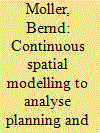|
|
|
Sort Order |
|
|
|
Items / Page
|
|
|
|
|
|
|
| Srl | Item |
| 1 |
ID:
117326


|
|
|
|
|
| Publication |
2013.
|
| Summary/Abstract |
In 2009, Jiangsu province of China supplied 99.6 percent of its total energy consumption with fossil fuels, of which 82 percent was imported from other provinces and countries. With rising energy demand, frequent energy shortages, and increasing pollution, it is essential for Jiangsu to put more emphasis on improving its energy efficiency and utilizing its renewable resources in the future. This paper presents the integrated energy pathway for Jiangsu during its social and economic transformation until 2050. EnergyPLAN is the chosen energy system analysis tool, since it accounts for all sectors of the energy system that needs to be considered when integrating large-scale renewable energy. A current policy scenario (CPS) based on current energy policies and an ambitious policy scenario (APS) based on large-scale integration of renewable energy and ambitious measures of energy efficiency improvement are proposed. The two energy pathways are modeled and compared in terms of technology combination, non-fossil fuel shares of primary energy supply, socioeconomic costs, and CO2 emissions. The insights from these pathways can provide valuable input for Jiangsu's future energy policies.
|
|
|
|
|
|
|
|
|
|
|
|
|
|
|
|
| 2 |
ID:
103595


|
|
|
|
|
| Publication |
2011.
|
| Summary/Abstract |
Offshore wind resources appear abundant, but technological, economic and planning issues significantly reduce the theoretical potential. While massive investments are anticipated and planners and developers are scouting for viable locations and consider risk and impact, few studies simultaneously address potentials and costs together with the consequences of proposed planning in an analytical and continuous manner and for larger areas at once. Consequences may be investments short of efficiency and equity, and failed planning routines. A spatial resource economic model for the Danish offshore waters is presented, used to analyse area constraints, technological risks, priorities for development and opportunity costs of maintaining competing area uses. The SCREAM-offshore wind model (Spatially Continuous Resource Economic Analysis Model) uses raster-based geographical information systems (GIS) and considers numerous geographical factors, technology and cost data as well as planning information. Novel elements are weighted visibility analysis and geographically recorded shipping movements as variable constraints. A number of scenarios have been described, which include restrictions of using offshore areas, as well as alternative uses such as conservation and tourism. The results comprise maps, tables and cost-supply curves for further resource economic assessment and policy analysis. A discussion of parameter variations exposes uncertainties of technology development, environmental protection as well as competing area uses and illustrates how such models might assist in ameliorating public planning, while procuring decision bases for the political process. The method can be adapted to different research questions, and is largely applicable in other parts of the world.
|
|
|
|
|
|
|
|
|
|
|
|
|
|
|
|
|
|
|
|
|